 |

| |

Some say açaí tastes like chocolate. Here, it even looks like chocolate! Belizza Antioxidant Sorbets photographed by Michael Steele. From the top, Açaí Banana, Pomegranate Raspberry and Açaí. |
| WHAT IT IS: Sorbets made from the “superfruits” açaí berry and pomegranate. |
| WHY IT’S DIFFERENT: The sorbets can claim “antioxidant” benefits based on the high ORAC values of the fruits. But, rather than look for health benefits from a sorbet, just enjoy them for their flavor. |
| WHY WE LOVE IT: Refreshing taste, unusual flavor combinations and more antioxidants than traditional sorbet flavors. |
| WHERE TO BUY IT: At fine food stores nationwide. See the list below or write info@belizza.com. |
|
|
 |

Belizza Antioxidant Sorbets:
Ask The ORAC-le
If there was one food trend at this year’s Summer Fancy Food Show, it was the evolution of the “superfruits” açaí and pomegranate beyond beverages, into everything from jams to cookies. America loves a reason to eat in the name of health (remember oat bran bagels and muffins?). Send out a news release that scientists have found curative properties in an obscure berry from the Himalayas, and headlines scream, “New Anti-Aging Superfood.”
Sometimes we feel like the food industry has gone a little bit P.T. Barnum. Today, ladies and gentlemen, we present for your eating pleasure the first line of “antioxidant sorbets”: six flavors made of açaí or pomegranate, including one tasty number that combines both. Is açaí sorbet “a virtual anti-aging energy vitamin disguised as a delicious sorbet,” as the manufacturer suggests? Put it this way: The USDA suggests 3,000 ORAC units* per day, which is easy to measure if you take vitamin supplements with the units stated on the bottle. But so far, there are no ORAC values listed on cartons of sorbet (or chocolate bars, pomegranate juice, green tea or any other foods—hopefully, that will come). A call to the manufacturer revealed that a half-cup serving has at least 2,000 ORAC units, with two of the flavors at 3,900 and 4,900 units. You can conclude that, if you’re going to eat a dessert, you’re better off with “antioxidant sorbet” than with “non-antioxidant sorbet”; and you’re far better off with sorbet in general than with chocolate cake or crème brûlée. So let’s get down to brass tacks: Of all the açaí and pom sorbets we’ve tasted, Belizza’s are the best. Whether or not we can count the ORAC units, if it tastes good and refreshing, it makes us feel happy and sprightly. Isn’t that an “anti-aging” defense? Read the full review below.
*The Oxygen Radical Absorbance Capacity (ORAC) assay is a method for measuring the total antioxidant activity of a biological sample. Read more about antioxidants and ORAC values.
- Read reviews of more of our favorite ice creams and sorbets in THE NIBBLE online magazine.
- See the Table of Contents of the July issue of THE NIBBLE, plus the prior issues archive and our most popular articles.
- All of the Top Pick Of The Week newsletters are permanently archived on TheNibble.com, in chronological order and by product category.
|
THE NIBBLE does not sell the foods we review
or receive fees from manufacturers for recommending them.
Our recommendations are based purely on our opinion, after tasting thousands of products each year, that they represent the best in their respective categories. |
Make Your Own Sorbet!
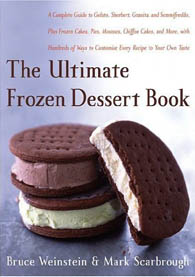 |
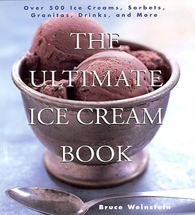 |
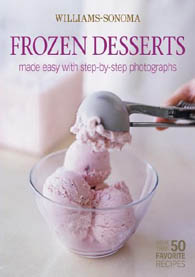 |
| The Ultimate Frozen Dessert Book, by Bruce Weinstein and Mark Scarbrough. There’s way more to frozen desserts than just ice cream sandwiches! Frozen cakes, semi-freddos and gelatos are among the many recipes you’ll find in this comprehensive cookbook. Click here for more information or to purchase. |
The Ultimate Ice Cream Book, by Bruce Weinstein. With delicious recipes for more than 500 ice creams, sorbets and granitas, you and your ice cream machine will be busy for several years—and your popularity quotient will soar. Click here for more information—and let us know what your favorite flavors are. |
Williams-Sonoma Frozen Desserts, by Melanie Barnard. This book acts as a mini cooking course, guiding you through the world of frozen desserts from start to finish. Work your way up from a simple ice cream all the way to an elegant torte. Click here for more information or to purchase. |
Belizza Antioxidant Sorbets: Ask The ORAC-le
INDEX OF REVIEW
|
MORE TO DISCOVER
|
About 4,000 years ago, the Chinese created a frozen dessert from syrup. Another 1,500 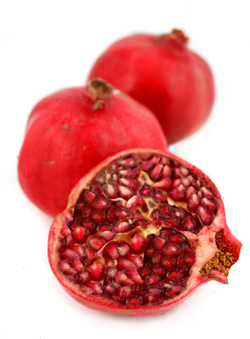 years passed, but ultimately, through trade routes, it was introduced to the Persian Empire. The Persians called their syrups cooled with snow sharbat—which means “fruit ice” in Arabic, and is the origin of the more familiar words sherbet and sorbet. Fruit ice finally reached the western world when Alexander the Great conquered the Persian Empire in 330 B.C. and brought it back to Greece. Three centuries later, the guests of Roman Emperor Nero ate fruit juices mixed with honey and snow; and today syrup and shaved ice are still enjoyed in Italy as well as in the “snow cones” of America and elsewhere. Thankfully, the ancient flavored ice and snow have evolved into smooth, creamy sorbet. And Persia is in the loop again, because the pomegranate—which originated in Persia*—is one of the hottest new flavors of sorbet. It is joined by açaí (pronounced ah-sigh-EE), a berry from the Brazilian açaí palm. Though one fruit comes from the semi-arid Middle East and the other from the Latin American rainforest, they share a bond as “superfruits.” They’re not just sweet nourishment; they’ve got an overabundance of nutrients and the potential to prevent disease. years passed, but ultimately, through trade routes, it was introduced to the Persian Empire. The Persians called their syrups cooled with snow sharbat—which means “fruit ice” in Arabic, and is the origin of the more familiar words sherbet and sorbet. Fruit ice finally reached the western world when Alexander the Great conquered the Persian Empire in 330 B.C. and brought it back to Greece. Three centuries later, the guests of Roman Emperor Nero ate fruit juices mixed with honey and snow; and today syrup and shaved ice are still enjoyed in Italy as well as in the “snow cones” of America and elsewhere. Thankfully, the ancient flavored ice and snow have evolved into smooth, creamy sorbet. And Persia is in the loop again, because the pomegranate—which originated in Persia*—is one of the hottest new flavors of sorbet. It is joined by açaí (pronounced ah-sigh-EE), a berry from the Brazilian açaí palm. Though one fruit comes from the semi-arid Middle East and the other from the Latin American rainforest, they share a bond as “superfruits.” They’re not just sweet nourishment; they’ve got an overabundance of nutrients and the potential to prevent disease.
*Persia is present-day Iran, although the larger Persian Empire also included Afghanistan, Azerbaijan, Turkey, portions of western China and northern Iraq. Photo of pomegranate by Graça Victoria | BST.
The 53rd Annual Summer Fancy Food Show has just ended, and more than 2,400 of the world’s manufacturers of specialty foods presented their wares to America’s retailers, caterers, restaurateurs and foodservice companies. If there was one inescapable trend, it was pomegranate this and açaí that. While pomegranate has an attractive tang, akin to cranberry, some people find straight açaí to be an acquired taste (and most companies blend it with more familiar fruits). But mix açaí into Dijon mustard, vinaigrettes, barbecue sauce, tea or whatever (as has been done with pomegranate for the last three years), and it fits right in.
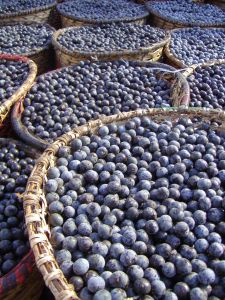 People may think that anything labeled “pomegranate” or “açaí” provides an antioxidant boost, akin to drinking green tea.† But here’s the rub: While you can take açaí supplement tablets that tell you exactly how many ORAC units you’re ingesting, no food product provides that information on the label. That pom product you’re eating/drinking could be significantly ORAC-ular, or it could have less value than a Steaz green tea soda (which no one has been hailing as an “antioxidant food”). To paraphrase Rod Tidwell in “Jerry Maguire,” show me the ORAC units. Of course, you’ll pack in more ORAC units with a glass of juice, or a sorbet that’s made largely from juice, than you will from a pomegranate vinaigrette. We contacted Belizza, and the ORAC values are impressive indeed; açaí sorbet a day will keep the doctor away. People may think that anything labeled “pomegranate” or “açaí” provides an antioxidant boost, akin to drinking green tea.† But here’s the rub: While you can take açaí supplement tablets that tell you exactly how many ORAC units you’re ingesting, no food product provides that information on the label. That pom product you’re eating/drinking could be significantly ORAC-ular, or it could have less value than a Steaz green tea soda (which no one has been hailing as an “antioxidant food”). To paraphrase Rod Tidwell in “Jerry Maguire,” show me the ORAC units. Of course, you’ll pack in more ORAC units with a glass of juice, or a sorbet that’s made largely from juice, than you will from a pomegranate vinaigrette. We contacted Belizza, and the ORAC values are impressive indeed; açaí sorbet a day will keep the doctor away.
†In case you were wondering, you need to drink eight cups of green tea a day to get your daily antioxidant surge. Photo of açaí berries by Ronaldo Salame | Sxc.
Will açaí and pom-based foods be a sweeping fad like oat bran, or become mainstream food like yogurt (which was not widely consumed in the U.S. before the late 1960s, but a niche product for ethnic groups with a yogurt heritage and “health nuts” who had read of the benefits of its probiotic bacteria). Whatever the future has in store, at present, the Belizza line can stand on its own as gourmet sorbet.
ICE CREAM, GELATO, SORBET: WHAT’S THE DIFFERENCE?
Sort out the confusion with our Ice Cream Glossary. |
Belizza Sorbet Flavors
Kudos to Belizza: The intensity of pure fruit flavor in their sorbets is no desert mirage. The company has done a great job with both the açaí and the pomegranate. There are three açaí flavors, two pomegranates, and an açaí-pomegranate blend which Belizza places in the pomegranate camp (to us, the exciting Pomegranate Açaí is the best of both worlds—why decide when both flavors are combined so perfectly for you?). On the açaí side, you may go ape for the Açaí Banana blend. All of the pom sorbets are winners, with more clarity of fruit than other pom sorbets we’ve sampled.
Açaí Sorbet Flavors
Açaí Sorbet. Açaí is an exotic fruit flavor—not in the lush way of a mango or papaya, but more in the way of something you need to contemplate, to get used to. It’s more approachable than goji or noni, but it has a different vocabulary than most of us are used to. With its deep purple color, there’s no doubt, as wine folks would say, the black fruits prevail. There’s some black cherry, blackberry and some plumminess; but then, some citrus tang and some pear.* The texture is grainy, like pear sorbet can be; it becomes almost unnoticeable when it is blended with other flavors. Overall, açaí is a masculine flavor: dark and strong, no sweet, feminine berry here. (4,800 ORAC units per half-cup serving)
*In other brands, for example Häagen-Dazs’ Açaí Sorbet, we’ve found a blackberry, blueberry and raspberry mix.
Açaí has been called “chocolaty,” and in many of the juices and other products on the market, it’s hard to relate to that descriptor. But in Belizza’s Açaí sorbet, you can taste the chocolate. Not “chocolate” as in ice cream, but chocolate notes that wine or coffee writers would describe. |

Basic Açaí: Macho man—a bit grainy for some, but
the biggest antioxidant hit. |
And yes, it tastes healthy—although the tag line, “The Healthiest Pleasure In The Universe,” might be an oversell (after a long day at the office or a weekend of chores, we’d rather have a massage!)

Açaí Banana Sorbet: Monkey around with me!
|
Açaí Banana Sorbet. Add banana to the açaí and you can hear the jungle: birds twittering, monkeys screeching and lots of good, ripe, familiar banana flavor topping of the exotic açaí. The puréed banana smoothes out most of the graininess in the pure açaí. It makes that exotic palmberry seem like one of the crowd while keeping its deep, Port-like color. (2,300 ORAC units per half-cup serving)
Açaí Mango Sorbet. When bright, yellow mango is added, the sorbet color takes on a lighter, almost yellow dark red cast. The flavor? We're not sure about this one. Its not the most natural of marriages. Mango has such a seductive and pronounced flavor, it doesn’t play well with others: It wants its own show. The blend is a flavor neither here nor there—tart and fruity but indistinct. It made us want a scoop of pure mango sorbet—or to monkey around with another scoop of Banana Açaí. Can we have some chocolate chips with that, while we’re at it? Sure, a few more antioxidants can’t hurt! (2,100 ORAC units per half-cup serving)
|
The açaí sorbets are made of açaí palmberry, water, pure cane sugar, citrus pectin (a thickener and stabilizer) and soy lecithin (an emulsifier), plus, as appropriate, banana or mango. Both pectin and lecithin are natural products made from plant cell membranes.
Pomegranate Sorbet Flavors
If açaí is the dark jungle hunter, pomegranate is sassy, dancing red fruits.
Pomegranate Açaí Sorbet is a great pom sorbet: frozen pom juice, not too sweet, a bit sharp and tangy, an intellectual’s red fruit sorbet. (2,800 ORAC units per half-cup serving)
For those who want more familiarity, Pomegranate Açaí Sorbet hits the spot. Adding pom juice to the açaí recipe makes it brighter. Though you can distinctly taste both fruits, it tempers the exoticism of the açaí—it tastes like something you could get at your good local scoop shop. In fact, Pomegranate Açaí was awarded Outstanding Diet and Lifestyle Product at the 2007 Summer Fancy Food Show. It may be a product for a healthy diet and lifestyle, but we’d give it an award because it’s a stunning sorbet. (3,900 ORAC units per half-cup serving)
Pomegranate Raspberry Sorbet is a sweet raspberry sorbet with a twist—tempered with a hint of pom. For people who don’t like things too different, it’s something a little more special. (2,300 ORAC units per half-cup serving) |

Pomegranate Açaí: A sexy sorbet, the
Outstanding Diet and Lifestyle Product from the
2007 Summer Fancy Food Show. |
The pomegranate sorbets are made from pomegranate juice, water, pure cane sugar, natural flavors and citrus pectin (plus açaí berries or raspberries).
Superfoods
In 2006, Stephen G. Pratt and Kathy Matthews wrote a book that got a lot of attention: SuperFoods Rx: Fourteen Foods That Will Change Your Life. They profiled simple, everyday supermarket foods 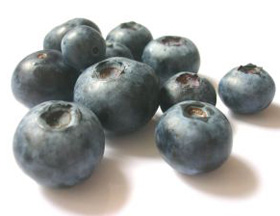 that are highly concentrated with a complex supply of quality nutrients—powerful enough to help maintain or lower cholesterol, lower blood sugar, reduce the risk of heart disease and inhibit growth of cancers. All one needed to do is include in one’s diet perfectly tasty beans, blueberries, broccoli, oats, oranges, pumpkin, salmon, soy, spinach, tea (black or green), tomatoes, turkey, walnuts and yogurt. The word “superfood,” which was already in use by nutritionists and the health-conscious, became hot. that are highly concentrated with a complex supply of quality nutrients—powerful enough to help maintain or lower cholesterol, lower blood sugar, reduce the risk of heart disease and inhibit growth of cancers. All one needed to do is include in one’s diet perfectly tasty beans, blueberries, broccoli, oats, oranges, pumpkin, salmon, soy, spinach, tea (black or green), tomatoes, turkey, walnuts and yogurt. The word “superfood,” which was already in use by nutritionists and the health-conscious, became hot.
Photo of blueberries by Chrissi Nerantzi | Sxc.
Not every superfood is an everyday grocery product. Bee pollen is the most famous, incredibly dense food with thousands of phytonutrients (plant nutrients) including enzymes, bioflavonoids, phytosterols, carotenoids, free amino acids, Omega 3 essential fatty acids, naturally chelated minerals and whole vitamin complexes. The açaí berry is considered a superfood because of its extremely high level of anthocyanins (an antioxidant), vitamins A and C, Omega 6 and 9 essential fatty acids, fiber and amino acids. It’s not enough to have a high ORAC value to be a superfood (see below), but to have a broad spectrum of nutrients.
The blueberry became known as a “superfruit” when its exceptional antioxidant properties were revealed in a USDA assay on antioxidant strength, or ORAC values, for 100 common foods. Wild blueberries were at the top of the 2004 rankings for fruit, but in new analyses published in 2005-2006, other berry fruits, such as açaí, chokeberry and black raspberry, showed even higher ratings.
What makes something a superfruit? Although there’s no scientific definition, most experts agree on high nutrient density, superior antioxidant strength and potential for disease impact.
ORAC Units
Several years earlier, the consumer world had been introduced to the concept of antioxidants—molecules that protect the body against the attack of potentially damaging free radicals, and thus slow aging and fight cancer, Alzheimer’s and other conditions. Different plants and vitamins were found to have significantly different levels of antioxidants. Cacao, Montmorency cherries and green tea, for example, were high on the list, as measured by the Oxygen Radical Absorbance Capacity (ORAC) test, a lab analysis that measures the antioxidant capacity of foods and other substances in a test tube. (The higher the ORAC value, the greater the ability of a substance to fight free radicals.)
Apples and bananas score about 220 ORAC units per 100 grams (3.5 ounces), whereas pomegranate extract has about 2,000 units, blueberries 2,400 units and açaí about 5,500. The USDA recommends 3,000 ORAC units per day for general health maintenance. So, you could down some açaí, or eat a heck of a lot of apples and bananas.
We need to note here that it isn’t easy getting an accurate read on ORAC values: Measurements are not often made using the same scale. Some evaluations compare units per grams of dry weight, others use wet weight, others use units per serving. Thus, if one picks and chooses numbers from different reports, different foods can appear to have comparatively higher or lower ORAC values than they actually do. Thus, for example:
- A raisin has no more antioxidant potential than the grape from which it was dried, yet raisins have a much higher ORAC value per gram wet weight than grapes, due to their reduced water content.
- Similarly, fruits with high water content can appear to be very low in antioxidants.
- To compare a dry product like chocolate to a wet product like blueberries is tenuous at best.
- No one is yet comparing the ORAC value per calorie–or, as mentioned earlier, stating the ORAC value on food labels.
Açaí
Heralded as the hottest superfood since bee pollen (and much more approachable in a normal diet), 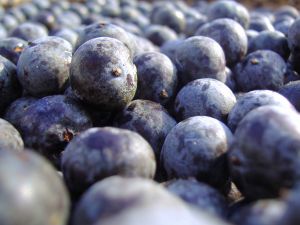 the açaí berry hit these shores two years ago from Brazil, in the form of juice drinks. The 1"-diameter fruit of the tall, slender açaí palm tree grows at the top of the tree in clusters. Some say it looks like purple grapes, although the large single seed takes up 80% of the center of the fruit. Harvested in the Amazon rainforest, the açaí berry can’t be sold fresh because it withers soon after it is picked. It is thus quickly turned into pulp. Brazilians enjoy it as a beverage and for breakfast with granola and sliced bananas—it provides sustained energy, not a quick burst. But here’s what makes it a “superfruit”: the açaí berry hit these shores two years ago from Brazil, in the form of juice drinks. The 1"-diameter fruit of the tall, slender açaí palm tree grows at the top of the tree in clusters. Some say it looks like purple grapes, although the large single seed takes up 80% of the center of the fruit. Harvested in the Amazon rainforest, the açaí berry can’t be sold fresh because it withers soon after it is picked. It is thus quickly turned into pulp. Brazilians enjoy it as a beverage and for breakfast with granola and sliced bananas—it provides sustained energy, not a quick burst. But here’s what makes it a “superfruit”:
Photo of açaí by Ronaldo Salame | Sxc.
- Extremely high antioxidant levels
- Essential amino acids that are vital to muscle growth and regeneration
- Omega essential fatty acids 6 and 9, which help lower LDL “bad cholesterol” and maintain healthy HDL levels
- Vitamins A, B, C and E
- Plant sterols, which help control cholesterol
- High levels of dietary fiber
Pomegranate
In 2002, America was introduced to a healthy new food, pomegranate juice. Prior to then, the pomegranate was an exotic-looking novelty food. Although pomegranates were one of the first five domesticated crops in the Fertile Crescent (along with dates, figs, grapes and olives), Americans have considered them difficult to eat. The arils (the fruit-covered seeds, shown in the photo at the right) have to be carefully 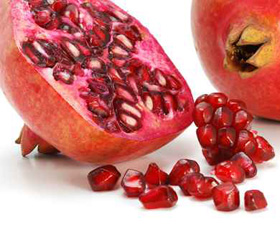 scooped out of the shell so as not to bruise the fruit. Some people enjoy eating both the fruit and the crunchy seed inside, while others (a large camp that is not fond of raspberry or blackberry seeds, either) suck the sweet flesh and spit out the seeds. Until recently, the arils have best been employed as colorful decor in fancy cuisine. scooped out of the shell so as not to bruise the fruit. Some people enjoy eating both the fruit and the crunchy seed inside, while others (a large camp that is not fond of raspberry or blackberry seeds, either) suck the sweet flesh and spit out the seeds. Until recently, the arils have best been employed as colorful decor in fancy cuisine.
But Pom Wonderful changed America’s perception of the pomegranate, giving a juice-loving population a new alternative in a cool bottle. It had a more sophisticated taste than cranberry juice and a new health benefit, turning the brand into a “superfruit juice” with more than $100 million in sales. Sales were helped, of course, by the USDA’s assay of high ORAC-value fruits.
What are the benefits of pomegranate? While pom has lower ORAC levels than açaí, it shares many of the same “superpowers,” plus three times the antioxidant properties of red wine or green tea:
- Flavonoids (a type of antioxidant) that neutralize cancer-causing free radicals
- Beneficial effects on heart disease, fertility and blood pressure
- Usefulness in treating prostate cancer and osteoarthritis
- A rich source of folic acid and vitamins A and E
- Potential to prevent the onset of osteoarthritis
You can get your full daily pom effect from drinking an eight-ounce glass of juice, and tablet supplements are available as well.
What’s next? Be on the lookout for guarana from Brazil (an ingredient in many energy drinks); mangosteen from Thailand (which doesn’t travel well but is now being grown in the Caribbean); lo han guo, seabuckthorn and goji (Chinese wolfberry) from China; and noni berries from Tahiti. (Goji and noni have already crept into specialty food and health food stores; and lo han guo, a sweet fruit, may be familiar because it’s processed into a low-calorie sweetener.)
Want something more familiar? Go for guava, lychee, pomelo, tamarind and yuzu. Are you an all-American eater? Blackberries, cranberries, red raspberries, red grapes and strawberries have many of the criteria to be “superfruits”—they just lack the novelty. But, remember the 14 superfoods in the Pratt and Matthews book: They might be mundane, but they could change your life.
And note: A cup of strawberries and a cup of strawberry sorbet don’t have the same ORAC value. Enjoy Belizza Antioxidant Sorbets for what they are: delicious desserts with something extra. They may not be “the healthiest pleasure in the universe”—certainly in some galaxy, a more advanced civilization than ours is enjoying negative-calorie, wrinkle-erasing hot fudge sundaes and muscle-building BLTs. But here on earth, for 110 calories a serving, Belizza Antioxidant Sorbets sure taste good, and will meet your USDA daily ORAC requirement. Sure, some of those flavors are less than 3,000 ORAC units per half cup—but who eats a half-cup serving?
—Karen Hochman
FORWARD THIS NIBBLE to anyone who likes sorbet and new food trends.
BELIZZA ANTIOXIDANT SORBETS
Açaí, Açaí Banana, Açaí Mango, Pomegranate, Pomegranate Açaí, Pomegranate Raspberry
- Pint
$4.79
Suggested Retail Price
Available at fine food stores nationwide, includingCentral Market, Safeway, Wegmans, Whole Foods Market and Wild Oats Marketplace (not in all regions for all chains). In Canada, Capers, Choices Market and Planet Organic Market. For a retailer near you, email info@belizza.com with your city/state/zip or call 1.925.602.5400 and press #1.
Prices and product availability are verified at publication but are subject to change.
For more information, visit Belizza.com.
Back to Index |
 |

|
Read more about our favorite
frozen desserts and related products in
THE NIBBLE online magazine.
|
Check Out These Other “Top Pick Of The Week” Frozen Desserts:
|
Do you have friends who would enjoy THE NIBBLE?
Click here to send them an invitation for the Top Pick Of The Week newsletter. |
ABOUT THE NIBBLE. THE NIBBLE™, Great Food Finds™, is an online magazine plus newsletters about specialty foods and the gourmet life. It is the only consumer publication and website that focuses on reviewing the best specialty foods and beverages, in every category. The magazine also covers tabletop items, gourmet housewares, and other areas of interest to people who love fine food. This e-mail from the editors features the Top Food Pick of the Week.
© Copyright 2004-2025 Lifestyle Direct, Inc. All rights
reserved. All information contained herein is subject to change at any time
without notice. All details must be directly confirmed with manufacturers, service
establishments and other third parties. The material in this e-zine may not
be reproduced, distributed, transmitted, cached, or otherwise used, except with
the prior written permission of Lifestyle Direct, Inc.
|
 |
|
 |









 years passed, but ultimately, through trade routes, it was introduced to the Persian Empire. The Persians called their syrups cooled with snow sharbat—which means “fruit ice” in Arabic, and is the origin of the more familiar words sherbet and sorbet. Fruit ice finally reached the western world when Alexander the Great conquered the Persian Empire in 330 B.C. and brought it back to Greece. Three centuries later, the guests of Roman Emperor Nero ate fruit juices mixed with honey and snow; and today syrup and shaved ice are still enjoyed in Italy as well as in the “snow cones” of America and elsewhere. Thankfully, the ancient flavored ice and snow have evolved into smooth, creamy sorbet. And Persia is in the loop again, because the pomegranate—which originated in Persia*—is one of the hottest new flavors of sorbet. It is joined by açaí (pronounced ah-sigh-EE), a berry from the Brazilian açaí palm. Though one fruit comes from the semi-arid Middle East and the other from the Latin American rainforest, they share a bond as “
years passed, but ultimately, through trade routes, it was introduced to the Persian Empire. The Persians called their syrups cooled with snow sharbat—which means “fruit ice” in Arabic, and is the origin of the more familiar words sherbet and sorbet. Fruit ice finally reached the western world when Alexander the Great conquered the Persian Empire in 330 B.C. and brought it back to Greece. Three centuries later, the guests of Roman Emperor Nero ate fruit juices mixed with honey and snow; and today syrup and shaved ice are still enjoyed in Italy as well as in the “snow cones” of America and elsewhere. Thankfully, the ancient flavored ice and snow have evolved into smooth, creamy sorbet. And Persia is in the loop again, because the pomegranate—which originated in Persia*—is one of the hottest new flavors of sorbet. It is joined by açaí (pronounced ah-sigh-EE), a berry from the Brazilian açaí palm. Though one fruit comes from the semi-arid Middle East and the other from the Latin American rainforest, they share a bond as “ People may think that anything labeled “pomegranate” or “açaí” provides an antioxidant boost, akin to drinking green tea.† But here’s the rub: While you can take açaí supplement tablets that tell you exactly how many ORAC units you’re ingesting, no food product provides that information on the label. That pom product you’re eating/drinking could be significantly ORAC-ular, or it could have less value than a
People may think that anything labeled “pomegranate” or “açaí” provides an antioxidant boost, akin to drinking green tea.† But here’s the rub: While you can take açaí supplement tablets that tell you exactly how many ORAC units you’re ingesting, no food product provides that information on the label. That pom product you’re eating/drinking could be significantly ORAC-ular, or it could have less value than a 


 that are highly concentrated with a complex supply of quality nutrients—powerful enough to help maintain or lower cholesterol, lower blood sugar, reduce the risk of heart disease and inhibit growth of cancers. All one needed to do is include in one’s diet perfectly tasty beans, blueberries, broccoli, oats, oranges, pumpkin, salmon, soy, spinach, tea (black or green), tomatoes, turkey, walnuts and yogurt. The word “superfood,” which was already in use by nutritionists and the health-conscious, became hot.
that are highly concentrated with a complex supply of quality nutrients—powerful enough to help maintain or lower cholesterol, lower blood sugar, reduce the risk of heart disease and inhibit growth of cancers. All one needed to do is include in one’s diet perfectly tasty beans, blueberries, broccoli, oats, oranges, pumpkin, salmon, soy, spinach, tea (black or green), tomatoes, turkey, walnuts and yogurt. The word “superfood,” which was already in use by nutritionists and the health-conscious, became hot. the açaí berry hit these shores two years ago from Brazil, in the form of juice drinks. The 1"-diameter fruit of the tall, slender açaí palm tree grows at the top of the tree in clusters. Some say it looks like purple grapes, although the large single seed takes up 80% of the center of the fruit. Harvested in the Amazon rainforest, the açaí berry can’t be sold fresh because it withers soon after it is picked. It is thus quickly turned into pulp. Brazilians enjoy it as a beverage and for breakfast with granola and sliced bananas—it provides sustained energy, not a quick burst. But here’s what makes it a “superfruit”:
the açaí berry hit these shores two years ago from Brazil, in the form of juice drinks. The 1"-diameter fruit of the tall, slender açaí palm tree grows at the top of the tree in clusters. Some say it looks like purple grapes, although the large single seed takes up 80% of the center of the fruit. Harvested in the Amazon rainforest, the açaí berry can’t be sold fresh because it withers soon after it is picked. It is thus quickly turned into pulp. Brazilians enjoy it as a beverage and for breakfast with granola and sliced bananas—it provides sustained energy, not a quick burst. But here’s what makes it a “superfruit”:  scooped out of the shell so as not to bruise the fruit. Some people enjoy eating both the fruit and the crunchy seed inside, while others (a large camp that is not fond of raspberry or blackberry seeds, either) suck the sweet flesh and spit out the seeds. Until recently, the arils have best been employed as colorful decor in fancy cuisine.
scooped out of the shell so as not to bruise the fruit. Some people enjoy eating both the fruit and the crunchy seed inside, while others (a large camp that is not fond of raspberry or blackberry seeds, either) suck the sweet flesh and spit out the seeds. Until recently, the arils have best been employed as colorful decor in fancy cuisine.